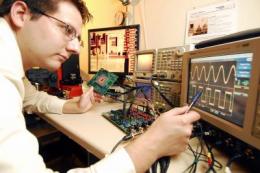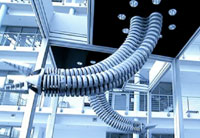Kit made for detecting food bacteria (03/12/2010)
 A cheap kit to analyze test result and quickly discover E. coli bacteria was invented by a group of Vietnamese scientists of the
A cheap kit to analyze test result and quickly discover E. coli bacteria was invented by a group of Vietnamese scientists of the
Project pioneers use of silicon-germanium for space electronics applications (30/11/2010)
 Georgia Tech student researcher Troy
Georgia Tech student researcher Troy
Robotic Arm Inspired By Elephant Trunk (30/11/2010)
 The British company Festo was inspired by the elephant trunk to develop a bionic arm.
The British company Festo was inspired by the elephant trunk to develop a bionic arm.
Called the Bionic Handling Assistant, the free-moving "third hand system," as Festo calls it, has plenty of uses in situtations that require support from machines. That can include medical technology, rehabilitation and as an aid for the handicapped, as well as in agriculture, private homes and educational institutes.
Are Security Scanners Safe? (28/11/2010)
Scientists want more scanner safety data before they can say yes.
Extra weight in early childhood foretells later disease risk (27/11/2010)
Ages 2 to 6 identified as critical for predicting problems with metabolic syndrome in adulthood
Azerbaijan aims for hi-tech state (26/11/2010)
The country’s desire to change all that though was highlighted this week at the Caucuses’ largest high-tech exhibition in
Cassini Back to Normal, Ready for Enceladus (25/11/2010)
 NASA's Cassini spacecraft resumed normal operations today, Nov. 24. All science instruments have been turned back on, the spacecraft is properly configured and Cassini is in good health. Mission managers expect to get a full stream of data during next week's flyby of the Saturnian moon Enceladus.
NASA's Cassini spacecraft resumed normal operations today, Nov. 24. All science instruments have been turned back on, the spacecraft is properly configured and Cassini is in good health. Mission managers expect to get a full stream of data during next week's flyby of the Saturnian moon Enceladus.
APEC meetings open with talk of Pacific Rim FTA (08/11/2010)
Officials from 21 Pacific Rim economies, including the
The series of Asia-Pacific Economic Cooperation meetings this week in Yokohama, just south of Tokyo, will culminate next weekend in a summit bringing together President Barack Obama, Chinese President Hu Jintao, Japanese Prime Minister Naoto Kan and 18 other leaders.
Sweden says US has carried out secret surveillance (08/11/2010)
People linked with the U.S. Embassy in
Newly Discovered Gene Enables Fish to 'Disappear' (31/10/2010)
 Researchers led by Vanderbilt's Roger Cone, Ph.D., have discovered a new member of a gene family that has powerful influences on pigmentation and the regulation of body weight.
Researchers led by Vanderbilt's Roger Cone, Ph.D., have discovered a new member of a gene family that has powerful influences on pigmentation and the regulation of body weight.
The gene is the third member of the agouti family. Two agouti genes have been identified previously in humans.









